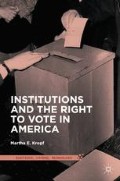Abstract
One of the newest methods of mobilizing citizens to the polls appears to be “vote shaming.” An example is from the former editor of an online newsletter for election scholars and election administrators across the country. “In his mailbox was an official-looking document detailing his voting history and comparing his voting history to his neighbors’.” The election guru was rather indignant about this piece of campaign mail because his voting “grade” was not as high as his neighbors’ grades because he had recently moved. He was quoted as saying:
I got one out of four bars, when, honestly, I’m [a] super voter. I vote in regional, local, national, any election you hold, I’ll vote in it. Because I moved in 2011, my federal election records indicate that, in [my new home], I voted in the November 2012 election and that’s it. But that’s completely wrong. I voted in every federal election since 1990.1
Access this chapter
Tax calculation will be finalised at checkout
Purchases are for personal use only
Preview
Unable to display preview. Download preview PDF.
Notes
Knoke, David. 1990. Political Networks: The Structural Perspective. Cambridge: Cambridge University Press.
Leighley, Jan E. and Jonathan Nagler. 2014. Who Votes Now? Demographics, Issues, Inequality, and Turnout in the United States. Princeton: Princeton University Press.
Bobo, Lawrence and Franklin D. Gilliam, Jr. 1990. “Race, Sociopolitical Participation and Black Empowerment.” American Political Science Review 84(2): 377–393.
Some more recent work conceptualizes identity not necessarily about just demographic or social groups to which one belongs, but also “lifestyle” groups. See Bennett, W. Lance. 2012. “The Personalization of Politics: Political Identity, Social Media, and Changing Patterns of Participation.” The Annals of the Academy of Political and Social Science 644(1): 20–39.
Huddy, Leonie and Simo V. Virtanen. 1995. “Subgroup Differentiation and Subgroup Bias Among Latinos as a Function of Familiarity and Positive Distinctiveness.” Journal of Personality and Social Psychology 68(1): 97–108.
The reader who is dissatisfied with the lack of explanation about how norms developed in the United States (listed in Chapter 2) may find some comfort in the idea that racial discrimination and stereotyping may, in part, have their genesis in the idea of social identity theory (see for example, Virtanen, Simo V. and Leonie Huddy. 1998. “Old Fashioned Racism and New Forms of Racial Prejudice.” Journal of Politics 60(2): 311–332
and Samson, Frank L. and Lawrence D. Bobo. 2014. “Ethno-Racial Attitudes and Social Inequality” in J. D. McLeod et al. (eds.) Handbook of the Social Psychology of Inequality. Handbooks of Sociology and Social Research. DOI 10.1007/978–94–017–9002–4_21.
Huddy, Leonie and Nadia Khatib. 2007. “American Patriotism, National Identity and Political Involvement.” American Journal of Political Science 51(1): 63–77.
A group of psychology scholars conducted field experiments using eating popcorn at the movies. David T. Neal, Wendy Wood, Mengju Wu, and David Kurlander. 2011. “The Pull of the Past: When Do Habits Persist Despite Conflict with Motives?” Personality and Social Psychology Bulletin 37(11): 1428–1437.
Aldrich, John H., Jacob M. Montgomery, and Wendy Wood. 2011. “Turnout as a Habit.” Political Behavior 33(4): 535–563.
There is a vast array of excellent and interesting scholarship on habit and voting, including for example, Plutzer, Eric. (2002). “Becoming a Habitual Voter: Inertia, Resources, and Growth in Young Adulthood.” The American Political Science Review, 96: 41–56
and Green, Donald P. , and Shachar, Ron. (2000). “Habit Formation and Political Behaviour: Evidence of Consuetude in Voter Turnout.” British Journal of Political Science, 30: 561–573.
Portes cites Berman, Sheri. 1997. “Civil Society and the Collapse of the Weimar Republic.” World Politics 49(3): 401–429.
See Portes, Alejandro. 2014. “Downsides of Social Capital.” Proceedings of the National Academy of Sciences of the United States of America 111(52): 18407–18408.
Klofstad, Casey A., Anand Edward Sokhey, and Scott D. McClurg. 2013. “Disagreeing About Disagreement: How Conflicts in Social Networks Affects Political Behavior.” American Journal of Political Science 57(1): 120–134.
For a comprehensive discussion of the use of network analysis, see Stephen P. Borgatti, Ajay Mehra, Daniel J. Brass, and Giuseppe Labianca. 2009. “Network Analysis in the Social Sciences.” Science 323(5916) (Feb. 13): 892–895.
Granovetter, Mark S. 1973. “The Strength of Weak Ties.” American Journal of Sociology 78(6): 1360–1380.
Leighley, Jan E. 2001. Strength in Numbers: The Political Mobilization of Racial and Ethnic Minorities. Princeton: Princeton University Press.
Uhlaner, Carole. 1989. “Rational Turnout: The Neglected Role of Groups.” American Journal of Political Science 33(2): 390–422.
Author information
Authors and Affiliations
Copyright information
© 2016 The Author(s)
About this chapter
Cite this chapter
Kropf, M.E. (2016). Exercising the Right to Vote. In: Institutions and the Right to Vote in America. Elections, Voting, Technology. Palgrave Macmillan, New York. https://doi.org/10.1007/978-1-137-30171-0_6
Download citation
DOI: https://doi.org/10.1007/978-1-137-30171-0_6
Publisher Name: Palgrave Macmillan, New York
Print ISBN: 978-1-137-30170-3
Online ISBN: 978-1-137-30171-0
eBook Packages: Political Science and International StudiesPolitical Science and International Studies (R0)

